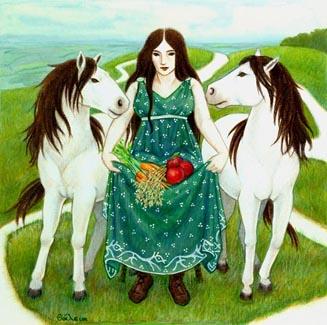~ Epona ~
(Information provided by Karen)

(Information provided by Karen)

The Divine Horse or The Divine Mare. She was often paired with Cernunnos - the Mare & the Stag being two potent fertility symbols. Otherwise She was sometimes paired with Taranis. The Celts revered the horse for several reasons - its beauty, speed, bravery & sexual vigour. The horse came to symbolise the warrior elite. They thought so much of their horses that their word for horse - epos - is incorporated in Her name. As part of her worship it was taboo to eat horse meat as a normal meal. Her cult had no special mystery and was popular. Apples and corn are some of her symbols and offerings, as were pigs. Her authority extended beyond death, accompanying the soul on its final journey. She is the only foreign Goddess to be adopted into the Roman pantheon. They often had a shrine to Her in every stable. The Romans gave Her the feast day of 18th December.

She was also a dream Goddess - her speciality seems to have been nightmares. There was a popular saying by parents to their children - if you don't sleep, Epona will come to give you nightmares. (Nice, huh?) The artist Henry Fuseli painted a picture called - "The Nightmare" reputed to be of Epona. (Click on the painting to see a larger version.)
A small ritual - just before dawn, find a place where two roads cross. They must be perfectly oriented to the four directions. Light 8 small fires, one for each side of the roads. Be sure to leave room for a rider & horse to pass through. Next, play 'horsey' yourself - ride 3 times around the intersection on a besom & then the fun begins. Sit & wait for a dark Lady dressed in black, riding a horse, fleeing the coming dawn. It is said to be Epona, returning from her night of dispensing dreams.
Epona was worshipped by people whose primary function was dependant on horses, such as cavalry, scouts, infantry, stable hands & grooms.
The main source of indirect evidence about Epona are several statues, bas-reliefs & painted depictions of Her. A few are of bronze.
The Giant Chalk Horse carved into the hill at Uffington in south Englandis belived to be associated with Epona. The probable date is 1400BCE, although this is disputed.
(Information provided by Jenny)

Epona is the Continental Celtic Horse Goddess who proved so popular She was adopted by the Romans. Shrines to Her could be found in stables, and it is likely the Romans brought Her worship with them to Britain, where She was unknown before, even though the people there were also of Celtic stock.
Her name comes from the Gaulish word for "horse", epos, which derives from the same root as both the Latin word for horse, equus and the Greek, hippos. Her name means "Divine Mare". Though Her name is said to give us our word "pony", the actual source of that word is from the Gaelic ponaidh and/or Irish poni.
Epona is the protectress of horses, animals, riders and stables. She is the Mistress of animals. Foals, dogs or birds followed her. Her many fertility attributes make her a Mothergoddess, which was maybe only reduced later to the horse-aspect. Or: The great importance of horses for the celts and the symbol of the fertile mare giving birth to a foal and taking gentle care of it as a loving mother led the celts to worship in her nature and fertility in general.
Epona is shown here in the so-called Imperial pose, the usual depiction of Her outside of Gaul. She is seated between two of the little wild horses known in the Camargue, the marshy area in the south of France. These horses (by modern standards, ponies, since they average about 13 hands high) are descended from ones that escaped from the Romans when they were in the area. They are a strange-looking variety, with square heads and a fay look, and though they are born dark brown or black they become white when they are adults, though some of them keep the dark mane and tail.
Epona and Her friends are depicted within the head of the White Horse of Uffington, in Wiltshire, England, with the Horse stretching out behind them and White Horse Vale in the background. The White Horse is likely a little too early to have been originally associated with Epona, as it's pre-Roman, and it was probably carved by a horse-worshipping Celtic tribe as a boundary marker.
Epona may well be related to the Welsh horse-goddess Rhiannon, and one of Epona's titles is "Queen"--in Latin, Regina, and in Gaulish, Rigatona, which later became the name Rhiannon.
Epona is also a fertility and abundance Goddess, and is shown holding in Her lap apples, carrots, and oats. Check out that horse on the left--he's like, "Are those treats I see? Are they for me?"
